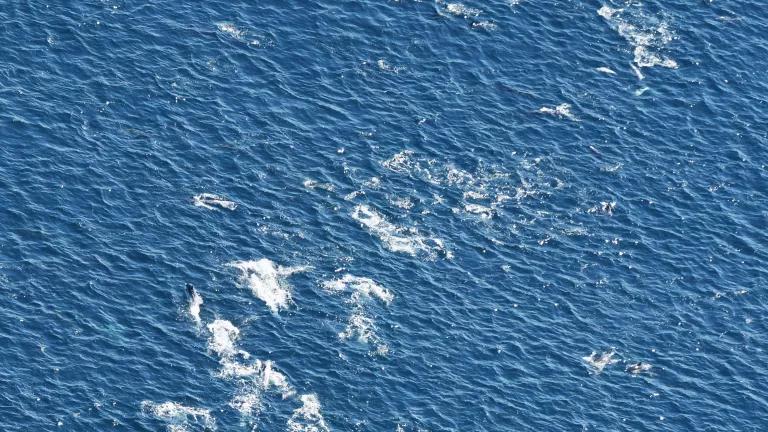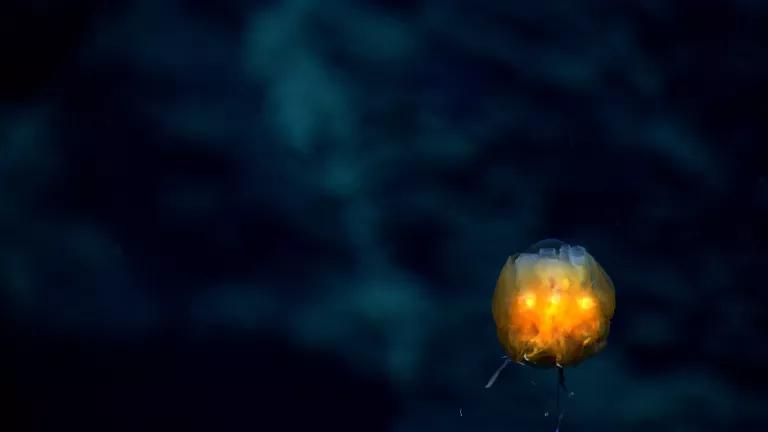Happy Birthday, Canyons and Seamounts!

Scientists flew over the Northeast Canyons and Seamounts Marine National Monument last week and observed more than 600 dolphins and whales in less than four hours. That’s a remarkable number in such a short time, and it’s a record for surveys of the monument to date. As in earlier surveys, many of the animals were calves and juveniles, which supports that the monument is an important nursery area. (Other blogs about aerial surveys of the area are here and here.)
I would like to think that all this ocean wildlife was in the monument for the same reason that ~150 people gathered at the Mystic Aquarium this Thursday evening: to celebrate the second anniversary of the monument’s designation. Today is the actual anniversary—President Obama designated the monument by proclamation on September 15, 2016. The highlights of the Aquarium celebration were a video message from Senator Blumenthal (D-CT) and a presentation by Dr. Peter Auster, an expert on the monument’s deep-sea ecosystems.
It’s been an eventful two years for the Northeast Canyons and Seamounts, the only marine national monument off the continental U.S. Let’s take stock.
The diverse coalition that supported the monument’s creation, as well as ocean lovers around the world, had about six months to savor the nation’s newest “blue park.” Then, in March 2017, several commercial fishing industry groups filed a legal challenge to the monument. The groups are represented by the Pacific Legal Foundation, an organization dedicated to very conservative pro-business causes. They claimed that Presidents lack legal authority under the Antiquities Act to designate national monuments in the ocean. This claim, if successful, would mean that not simply this monument designation but numerous other marine monument designations by prior Presidents, including George W. Bush, are illegal. The groups also claim that the Canyons and Seamounts monument is too big, even though it was reduced significantly from original proposals in a compromise with fishing industry groups that would still protect rich and at-risk canyon and seamount ecosystems.
Needless to say, NRDC and other monument supporters sought and ultimately were granted intervention in the case. We are committed to defending the Canyons and Seamounts monument—and its natural wealth of marine mammals, sea birds, sea turtles, fish, and centuries-old deep-sea corals—against legal attack. We are equally committed to defending the authority of Presidents to use the Antiquities Act to protect the most important and at-risk of our nation’s natural heritage—including in the ocean—in posterity for future generations. Scientists believe that we actually need many more ocean areas like the monument set aside from commercial extraction in order to protect global fisheries and ocean ecosystem health, particularly against the ravages of climate change. Today, more than 99% of the ocean areas around the country that are protected from commercial extraction are in our marine national monuments.
In April 2018, we were pleased when the federal government decided to defend the monument designation and Presidential authority to designate marine national monuments more generally by filing a motion to dismiss the fishing groups' lawsuit. I should really say the government is defending the monument designation for now. The government’s filings have left it room to change its mind and try to weaken the monument pursuant to the "review" process I elaborate on below. In any event, NRDC and the other intervenors have supported the government’s motion, as have law professors who filed two supporting briefs. The parties now await the court’s decision.
In April 2017, a month after the commercial fishing groups filed their challenge, President Trump piled on. In an unprecedented assault on our public lands and waters, he issued two executive orders initiating two different reviews of a lengthy list of both land and marine monuments, including Canyons and Seamounts, as well as a number of national marine sanctuaries. The hardly-concealed goal of the reviews was to develop proposals for monument and sanctuary rollbacks—either in size or scope of protections—for the benefit of extractive industries.
Over the summer of 2017, the Interior Department and the Commerce Department, each responsible for one of the reviews, accepted public comment. And the public certainly commented—more than 225,000 people signed letters of support for this monument and almost 3,000,000 people signed letters of support for all monuments. Submissions in support of the Canyons and Seamounts monument included letters signed by dozens of federal and state elected officials, almost 100 business owners, 65 faith leaders, almost 120 recreational fishermen and two dozen aquariums. The former deputy chief economist for NOAA submitted an in-depth analysis showing that the monument was unlikely to have adverse, and might even have positive, impacts on commercial fishing.
In December 2017, Secretary of the Interior Zinke released to the public his report and recommendations to the President. Despite the clear public outrage over the prospect that the nation’s natural heritage was literally going to be given away to private companies and industries, Secretary Zinke recommended downsizing and/or removing protections for almost a dozen monuments. For the Canyons and Seamounts, Zinke’s recommendation would result in opening up the monument to commercial fishing. The Commerce Department has yet to make public any result of its review, but an internal NOAA presentation cited opening marine monuments to commercial fishing as a “goal” to “reduce America’s seafood trade deficit.” Such an action would essentially strip the area of monument protection, as commercial fishing is the only extractive industry that poses an imminent threat.
Commercial fishing gear can entangle, unintentionally catch, and physically harm corals, marine mammals, seabirds, sea turtles, and other animals. Commercial fishing can also remove large numbers of forage fish, reduce top predators, and cause other harms to ecological health. Because the President lacks the legal authority to weaken the monument so drastically, NRDC would sue if the Trump Administration opens the area to commercial fishing.
In July 2018, an inadvertently-disclosed set of internal Interior documents underscored exactly how much the agency’s monument review had a predetermined outcome, including for the Canyons and Seamounts. A Washington Post report on the disclosure revealed that the Trump Administration omitted key economic data in its review, because highlighting the actual percentage of annual landings that fishing vessels generated from the Canyons and Seamounts monument would “undercut[t] the case for the ban being harmful.”
We now know that there is no “case” that the monument has harmed commercial fishing. As I wrote about here, government landings and revenues data show no drop in 2017 compared to the period before designation. The monument is less than 1.5% of the U.S. Atlantic. It is remote, rugged, and deep and was never a critical fishing spot. It is now readily apparent that those fishing vessels that had been fishing in the monument are now catching the small amount of fish they used to catch there somewhere else.
As this anniversary tolls, whatever the trials and tribulations of the last two years, the legions of monument supporters have not been cowed, as the Mystic event on Thursday showed. Nor has the monument’s wildlife, which continues to astound the scientists and delight the public.
We all look forward to many more monument birthdays—and celebrations.


